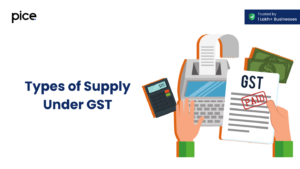Know the Four-Level Administrative Structure of GST
- 11 Aug 24
- 16 mins

Know the Four-Level Administrative Structure of GST
Key Takeaways
- Unified Tax System: GST merged multiple taxes into one, simplifying the tax landscape and reducing the burden on businesses and consumers.
- Components of GST include CGST, SGST, IGST, and UTGST, facilitating a dual model of taxation that ensures revenue sharing between the central and state governments.
- Important Factors: GST is all-encompassing, has multiple stages, and is based on destination. It puts a lot of emphasis on digital compliance and gets rid of the tax cascading effect through the input tax credit mechanism.
- Tax Slabs and Exemptions: Offers a structured tax slab system ranging from zero rates for exports and essential goods to higher rates for luxury items, balancing affordability and revenue generation.
- Composition Scheme: Aids small businesses by allowing them to pay GST at a fixed rate of turnover, simplifying compliance and minimizing tax liabilities.
The Goods and Services Tax (GST) is an enormous shift in the way taxes are done in India. It went into effect on July 1, 2017. It has changed the way secondary taxes are done by combining several taxes into a single scheme. Getting rid of the "cascading effect" of taxes was the point of this change. Customers would save money on goods and services because of this, and businesses would find it easier to pay their taxes.
Components of GST
GST in India is structured around four main components, each serving a specific purpose in the tax mechanism:

- CGST (Central Goods and Services Tax): Levied on the intra-state supply of goods and services by the central government.
- SGST (State Goods and Services Tax): Imposed alongside CGST on intra-state transactions, collected by the state government.
- IGST (Integrated Goods and Services Tax): Applied to inter-state transactions and imports, with the revenue shared between the central and state governments.
- UTGST (Union Territory Goods and Services Tax): Similar to SGST, but collected by Union Territories without a legislature.
Salient Features of GST
GST is known for its comprehensive, multi-stage, destination-based tax system. It is levied at every point of sale, with the final consumer bearing the tax. Credits of input taxes paid at each stage will be available for set-off at a subsequent stage, making GST essentially a tax only on the value addition at each stage.
- Unified Tax System: GST amalgamates several previous taxes and levies, including VAT, service tax, excise duty, etc., into a single tax. This simplification helps reduce the complexity of the tax system, making it easier for businesses and consumers to comply.
- Dual GST Model: India has adopted a dual GST model, meaning that both the central and state governments levy taxes on the supply of goods and services. This model comprises the Central GST (CGST), State GST (SGST), and Integrated GST (IGST) for inter-state transactions and imports.
- Input Tax Credit Mechanism: One of the cornerstone features of GST is the seamless input tax credit system. It allows businesses to claim credit for the tax paid on inputs (goods and services used in the production process), reducing the overall tax burden and eliminating the cascading effect of taxes.
- Destination-Based Tax: GST is a destination-based tax, implying that the tax is collected by the state where the goods or services are consumed as opposed to where they are produced. This feature aligns with global practice and ensures tax revenue accrues to the consuming state.
- Digitalization of Compliance Procedures: GST has introduced and mandated digital compliance mechanisms, including registration, return filing, and tax payments through the GST portal. This digital approach enhances transparency, reduces paperwork, and simplifies the tax compliance process.
- Comprehensive Coverage: GST applies to almost all goods and services with minimal exemptions. This universal applicability helps in broadening the tax base and reducing economic distortions caused by differential taxation of goods and services.
- Multiple Tax Slabs: GST is levied at multiple rates, depending on the nature of goods and services. Essential items are taxed at lower rates, luxury and sin goods at higher rates, and a standard rate for most goods and services. This structure aims to achieve a balance between revenue generation for the government and affordability for consumers.
- Composition Scheme for Small Businesses: The GST framework offers a composition scheme for small businesses, allowing them to pay GST at a fixed rate of their turnover. This scheme simplifies the compliance burden and reduces the tax liability for small and medium enterprises.

- Anti-profiteering Measures: The GST law includes provisions to ensure that the benefits of tax rate reductions and input tax credits are passed on to consumers. This anti-profiteering mechanism aims to prevent unjust price increases and protect consumer interests.
- E-way Bill System: For the transportation of goods, the GST regime has introduced the electronic way bill (E-way bill) system. This system facilitates the tracking of goods movement, ensures tax compliance, and reduces the chances of tax evasion.
Detailed Structure of GST
- Zero Rate
Zero-rated supplies are one of the most notable features of the GST system, primarily aimed at boosting exports and certain other sectors by making them more competitive on a global scale. Under this category, exports of goods and services, as well as supplies to Special Economic Zones (SEZs), are taxed at a 0% rate.
Despite the imposition of taxes on inputs, exporters can claim a full refund of the GST paid on these inputs, effectively making the export price of goods and services more competitive in international markets. This mechanism ensures that taxes do not become a cost to exporters, thereby promoting Indian exports.
- Lower Rate (5%)
The 5% tax slab is designed to include essential items which are crucial for daily living and, thus, need to be made affordable to the general population. This category includes basic food products such as edible oils, tea, coffee, and essential services.
The rationale behind this reduced rate is to minimize the financial burden on consumers for essential commodities and services, ensuring that basic needs are accessible to all segments of society without significant tax implications.
- Standard Rate (12–18%)
The standard GST rates of 12% and 18% cover the majority of goods and services available in the market.
This slab is carefully calibrated to ensure tax neutrality, meaning that it neither encourages nor discourages consumption of these items solely based on tax rates.
The products covered by these categories include, among others, computers, restaurant services, and processed foods. Either way, this is very necessary for the government, as tariff tax collection provides revenue for the development of infrastructure and the provision of public services.
Reasons Behind the Structure
The multi-tiered structure of GST is designed to achieve several objectives:
- Fairness and Affordability: By applying lower rates to essential goods and services, the GST structure ensures that basic commodities remain affordable to the general population.
- Revenue Generation: The standard and higher tax rates on non-essential and luxury items ensure that the government has a steady revenue stream to fund public services and infrastructure projects.
- Promotion of Exports: The zero rate on exports makes Indian goods and services more competitive in the global market, encouraging growth in the export sector.
- Reduced Tax Burden: The ability to claim input tax credit reduces the overall tax burden on the supply chain, leading to lower costs for consumers and businesses alike.
Importance of GST Structure

Grasping the GST structure is crucial for businesses and professionals alike. It assists in compliance, brings accuracy to tax credit claims, and simplify information-based decision-making processes. As a result, it ultimately facilitates running the business seamlessly with minimal taxes.
- Compliance: A thorough understanding of the GST structure is essential for compliance. Companies must understand the rates, exemptions, and return filing procedure for Goods and Services Tax (GST) before applying it to their goods or services. There can be fines, interest, and harm to a company's image for noncompliance.
- Input Tax Credit Utilization: GST allows businesses to claim input tax credit (ITC) for taxes paid on inputs used in the production or delivery of services. Understanding the structure and conditions under which ITC can be claimed is vital to optimizing tax savings and improving cash flow.
- Decision Making: Knowledge of GST rates and exemptions helps businesses price their goods and services competitively. It is also affecting the selection of input, sourcing, locations, and supply chain structuring to minimize the tax impact.
- Reducing the Cascading Effect of Taxes: One of the primary goals of GST is to eliminate the cascading effect of taxes, where tax is levied on tax. By knowing how GST operates, the companies can then structure their operations in such a manner that the tax burden is minimized and there is a lower cost of production of goods and services.
- Ease of Doing Business: With GST, the process of starting and operating a business has become more straightforward due to uniform tax rates and procedures across the country. There is a high possibility that knowledge of GST law can eliminate the brake that leads to the creation of new ventures or the expansion of existing ones across different states.
- Transparency and Accountability: The GST system promotes transparency and accountability in the taxation process. Companies and experts who understand the GST system are better off in terms of complying with Tax laws and making the system formal.
- Dispute Resolution: Knowing how GST works will make it easier to fix its mistakes and arguments with the tax authority department. In such a case, the law knowledge together with the law mechanisms will be very useful for on-time and site goals and court suit avoidance.
- International Competitiveness: For businesses engaged in exports, understanding zero-rated supplies and how GST refunds are processed is crucial. Such information is useful in setting a price that competitively fits the global market. This opportunity will help Indian companies become globally competitive.
- Consumer Awareness: For consumers, an understanding of GST helps in recognizing the tax component in the price of goods and services. This awareness can lead to more informed decisions and advocacy for fair pricing.
- Adaptation to Changes: The GST law and its provisions are subject to updates and changes based on economic needs and policy decisions. Modernization of the GST system with continuous monitoring of the changes is an integral component of proactive and sustainable compliance.
Key Features of the Composition Scheme
- Simplified Tax Rates: Businesses enrolled in the Composition Scheme are required to pay GST at a nominal rate, which is significantly lower than the regular GST rates. These rates vary for traders, manufacturers, and restaurants.
- Reduced Compliance: Businesses opting for this scheme have to file quarterly returns instead of the monthly returns required for regular taxpayers under GST. This significantly reduces the compliance burden and simplifies the process of filing returns.
- Restrictions on Input Tax Credit (ITC): One of the downsides of opting for the Composition Scheme is that businesses cannot claim input tax credit. This is because the scheme allows for payment of taxes at nominal rates.
- No Inter-state Sales: Businesses opting for the Composition Scheme are not allowed to make inter-state sales. This limitation is in place because the scheme is designed to simplify taxation for small, local businesses.
Benefits of the Composition Scheme
- Ease of Doing Business: The scheme simplifies the GST process for small businesses, making it easier for them to comply with tax regulations.
- Lower Tax Liability: The fixed, lower rate of tax helps in reducing the tax liability, making it a cost-effective option for eligible businesses.
- Reduced Compliance Costs: With lesser compliance requirements, such as fewer return filings, businesses can save on operational costs associated with tax compliance.
- Simplification of Tax Payments: The scheme simplifies the process of calculating and paying GST, as taxes are paid at a fixed percentage of the turnover without the need to maintain detailed records of inputs and outputs.
Considerations Before Opting for the Composition Scheme
While the Composition Scheme offers several benefits, businesses should consider their operational model and future plans before opting in. The inability to make inter-state sales and the non-eligibility to claim input tax credit may not suit all business models, especially those looking to expand or those with significant input taxes.
Benefits of GST

GST has streamlined the tax administration by consolidating multiple taxes, reducing the compliance burden, and making the tax system more transparent. It has also facilitated a common national market, improved the competitiveness of Indian goods and services, and stimulated economic growth.
- Elimination of Cascading Tax Effect
One of the most significant advantages of GST is the elimination of the cascading effect of taxes, where tax on tax was previously a burden on consumers. GST allows for input tax credit (ITC), meaning businesses can reduce the taxes on inputs from the taxes on outputs, thereby lowering the end cost to consumers and enhancing the efficiency of businesses.
- Higher Threshold for Registration
Under the GST regime, the threshold for registration has been increased, allowing small traders and service providers to be exempt from GST if their annual turnover is below a certain limit.
This limit of exemption has significantly reduced the tax burden and compliance requirements for small businesses.
- Composition Scheme for Small Businesses
The composition scheme under GST is designed for a simpler taxation process for small businesses where they are liable to pay GST at a fixed rate of turnover. This plan will reduce the number of steps in the tax procedure and lower compliance costs for entrepreneurial small and medium enterprises (SMEs).
- Improved Efficiency of Logistics
GST has brought about the removal of many state taxes and barriers and has led to enhanced efficiency of logistics and transit in the country as a whole.
With the disappearance of logistics expenses, Indian manufacturers have become more and more cost-effective, resulting in an increase in demand for domestic products both in national and global markets as well.
- Regulated Unorganized Sector
GST has brought accountability and regulation to the unorganized sector, including industries like textiles and construction. With GST, there are provisions for online compliances and payments and availing input credit only if the supplier has accepted the amount, which has brought in transparency and accountability.
- Easier Online Procedure
The entire GST process, from registration to filing returns, is made online, simplifying the procedure and making it more transparent. This digital approach has made compliance easier and more efficient for businesses.
- Uniform Tax Rate and Structure
GST has introduced a uniform tax rate across the country, eliminating the previous complex and varied tax structures that varied from state to state. This uniformity has helped in creating a single national market, which has been beneficial for the economy.
- Boost to Export
The GST system allows zero-rated taxes on exports, enhancing the competitiveness of Indian goods in the international market. Exporters can also claim input tax credit, which decreases the cost of production and boosts Indian exports.
- Increased Government Revenues
By simplifying the tax structure and making compliance easier, GST has widened the tax base and improved tax compliance rates. This has led to an increase in government revenues, which can be used for public and social welfare projects.
- Enhanced Economic Growth
Through the establishment of a more open and competitive business arena, GST can be a driving force for foreign investments and can lead to economic growth. Elimination of indirect fees results in a more economical production process, which boosts production and consumption.
Conclusion
The GST system in India has by and large helped standardize the fiscal regime, so compliance is promoted and the business community is encouraged. Understanding its structure thus becomes a fundamental thing in order to enable the highest returns, enhance compliance, and contribute to informed business decisions of all types.
Furthermore, this holistic strategy has not only simplified the tax system but also provided a gateway for a more transparent, efficient, and fair economic environment.
💡Learn more about how our PICE business payment application can help business owners use their credit cards to pay any and all business expenses. . Download the app now.
 By
By 

















